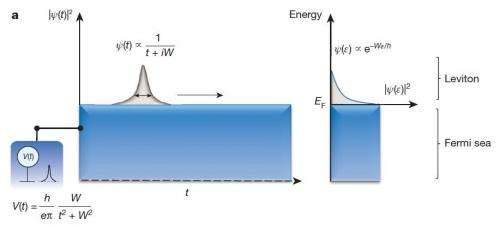October 24, 2013 report
Researchers produce the first experimental pulse-generation of a single electron—a leviton

(Phys.org) —A team of researchers in France has produced the first experimental pulse-generation of a single electron—they've named it a leviton, in honor of physicist Leonid Levitov and its resemblance to a soliton. In their paper published in the journal Nature, the team describes how they caused the leviton to come about and how it might be used in future applications.
Seventeen years ago, Levitov and colleagues suggested that if a voltage was applied to a nanocircuit and varied over time according to the mathematical expression of a Lorentzian distribution, it should be possible to excite a single electron peak in a sea of electrons. In this new effort, the researchers in France have proved the theory to be true and in the process have opened the door to a whole new subfield of physics involving the use of quantum excitations.
The researchers achieved their goal by building a nanocircuit, which was essentially a nanoscale electrode, to create what is known as a Fermi sea—where electrons are held in a tiny device. They then cooled the circuit to near absolute zero and then applied voltage that varied in time to stir up the electrons—creating chaotic peaks and valleys. Adjusting the time variations to fit the Lorentzian distribution allowed for creating just one single peak—the long sought after leviton. The researchers compare their experiment to a tub of water, stirring causes chaotic waves to form, adding more water (electrons) causes the water level to rise, while letting some out similarly causes the level to fall. But, if the water is stirred in just the right way, as Scottish engineer John Scot Russell observed back in the late 1800's, a soliton can form—a tsunami type wave where the energy in it is not dispersed as it moves across the surface.
This is not the first time single-electron excitations have been caused to come about, but it is the first time it's been done without having to resort to building a special nanostructure. Because of that, the researchers say, it now appears possible to scale up such a circuit to allow for building larger systems that could conceivable carry quantum information.
More information: Minimal-excitation states for electron quantum optics using levitons, Nature (2013) DOI: 10.1038/nature12713
Abstract
The on-demand generation of pure quantum excitations is important for the operation of quantum systems, but it is particularly difficult for a system of fermions. This is because any perturbation affects all states below the Fermi energy, resulting in a complex superposition of particle and hole excitations. However, it was predicted nearly 20 years ago that a Lorentzian time-dependent potential with quantized flux generates a minimal excitation with only one particle and no hole. Here we report that such quasiparticles (hereafter termed levitons) can be generated on demand in a conductor by applying voltage pulses to a contact. Partitioning the excitations with an electronic beam splitter generates a current noise that we use to measure their number. Minimal-excitation states are observed for Lorentzian pulses, whereas for other pulse shapes there are significant contributions from holes. Further identification of levitons is provided in the energy domain with shot-noise spectroscopy, and in the time domain with electronic Hong–Ou–Mandel noise correlations. The latter, obtained by colliding synchronized levitons on a beam splitter, exemplifies the potential use of levitons for quantum information: using linear electron quantum optics in ballistic conductors, it is possible to imagine flying-qubit operation in which the Fermi statistics are exploited to entangle synchronized electrons emitted by distinct sources. Compared with electron sources based on quantum dots, the generation of levitons does not require delicate nanolithography, considerably simplifying the circuitry for scalability. Levitons are not limited to carrying a single charge, and so in a broader context n-particle levitons could find application in the study of full electron counting statistics. But they can also carry a fraction of charge if they are implemented in Luttinger liquids3 or in fractional quantum Hall edge channels; this allows the study of Abelian and non-Abelian quasiparticles in the time domain. Finally, the generation technique could be applied to cold atomic gases, leading to the possibility of atomic levitons.
Journal information: Nature
© 2013 Phys.org


















